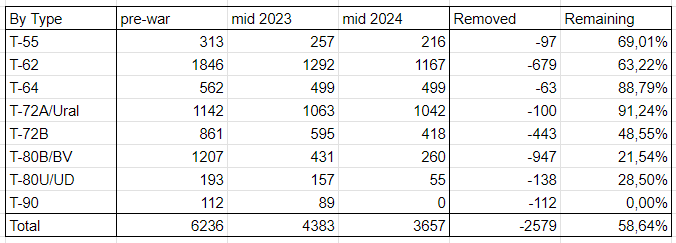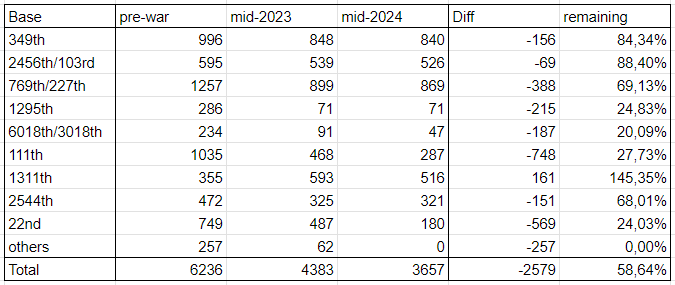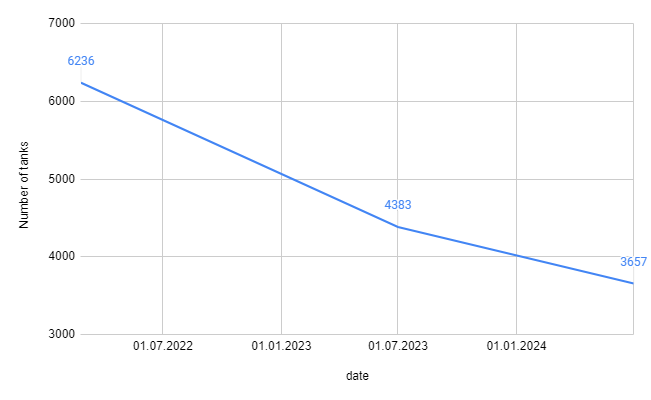1/ Getting reliable data regarding attrition of the Russian artillery forces is very hard, but there are some trends that can be observed based on what is being removed from the storage bases, which I will present in this thread.⬇️ 

2/ Here are the equipment numbers visible on satelite images. Almost 11000 towed artillery units, self-propelled guns and towed mortars have been removed from visible storage since the start of the invasion. 

3/ A large inital drop in the number of stored artillery systems can be observed. These were likely needed for the force expansion after the mobilization, since towed guns can be reactivated faster than SPGs, which have been removed at a more linear rate of roughly 900 per year. 

4/ Sadly the most important discovery is that the last two and a half years of attrition have so far not caused a general shortage in artillery systems for the Russian army. In my opinion the limiting factor is likely still ammunition, but at some point likely also barrels.
5/ It is not really possible to get open source and reliable data on the real attrition rate of artillery systems, ammunition stockpiles or barrel production, which makes any calculation or prediction very inaccurate, but some trends can be drawn from the numbers above.
6/ The first observation is unsurprisingly, that the stocks of more capable and longer range systems have often been depleted at higher rates compared to other systems. This will lead to a slow decline in average range, across the active fleet of russian artillery systems.
7/ One example are the Giatsint guns: the towed Giatsint-B 2A36 and its self-propelled version the Giatsint-S (2S5). They have initially been removed at a high rate, but there has been very little change since mid 2023. 

8/ Both systems are very capable and have a long range. In my opinion the reason for the reduced removal rate is likely that they use different ammunition than other 152mm systems, limiting the number of active systems.
https://x.com/ChungTzuW/status/1689372309545525248
9/ Another interesting, but also obvious observation is that the average age of Russian artillery systems is rising. One example was the introduction of the D-20, which entered production in 1955 or more recently the M-46, that entered production in 1951.
10/ The 130mm M-46 was not in service before the war started and it is unclear if they were reactivated, because of a lack of long range guns or some other reason, such as a new source of 130mm ammunition (North Korea or Iran). Roughly 380 have been removed from storage. 

11/ Furthermore all of the stored SPG types have seen at least some cannibalization. Making an accurate assesment of this from satelite footage is really hard, but I would suggest an average cannibalization rate of 25% (SPGs). I also found these 15 2A36 without a barrel. 

12/ The most cannibalized system is likely the 2S7. Only 72 of 218 systems remain in storage and most of the remaing units had their guns or other parts removed, which can be seen in these images from the 94th Arsenal in Omsk.




13/ Additionally I have to add that a large fraction of the remaining towed artillery in storage is made up of older systems that are currently not in service in larger numbers such as the D-1, M-30 and D-44.
https://x.com/HighMarsed/status/1836804095065137549
14/ My guess would be that they make up at least half of the remaining units and are mostly D-1 and M-30. I have identified at least 1300 M-30s in satelite images from 2021, but there could definetly be even more of them.
15/ It is still unclear how useful many of these system will be, but some are probably completely useless such as remaining ZiS-2/3, but others such as the D-44 might be more useful. Ukraine has even used the D-44 and there is one entry for a gun of this type on Oryx.
16/ I have previously speculated if Russia does have access to the appropriate ammunition for some older systems, but I think they can likely solve those issues, because the russian allies often operate these older systems or chinese copies (f.x. Type-54).
17/ There are likely a lot less useful units remaining at the storage bases than the total numbers from the beginning of the thread would suggest, but Russia clearly still has some reserves to draw on including some capable system.
18/ In my opinion a sign for a true shortage of more modern artillery systems would be, if we start seeing a large number of D-1 and M-30 being used at the front, since they are both clearly inferior to the systems that replaced them (D-20 and D-30).
19/ I know there is a video of Wagner soldiers firing a D-1 and a damaged M-30 is listed on Oryx, but this is not enough evidence to suggest that these systems are used in significant numbers.
https://x.com/RALee85/status/1616168127653363718
• • •
Missing some Tweet in this thread? You can try to
force a refresh















